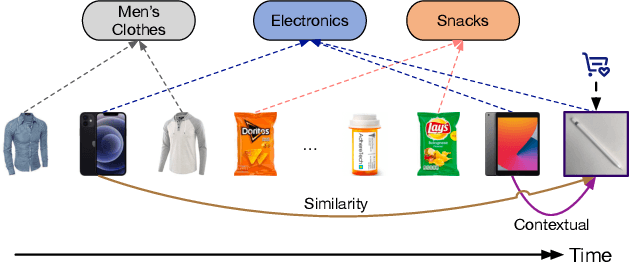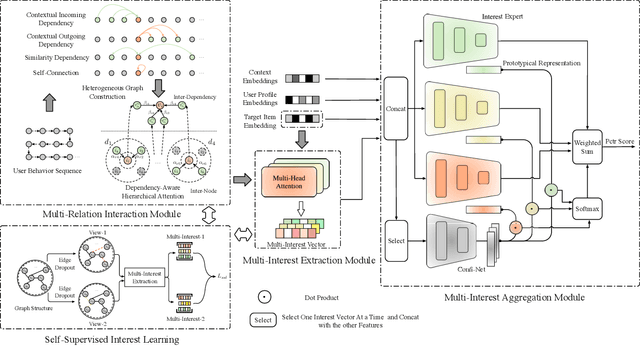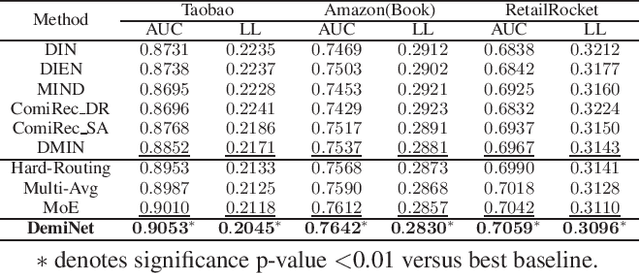Yule Wang
A Revisit of Total Correlation in Disentangled Variational Auto-Encoder with Partial Disentanglement
Feb 04, 2025Abstract:A fully disentangled variational auto-encoder (VAE) aims to identify disentangled latent components from observations. However, enforcing full independence between all latent components may be too strict for certain datasets. In some cases, multiple factors may be entangled together in a non-separable manner, or a single independent semantic meaning could be represented by multiple latent components within a higher-dimensional manifold. To address such scenarios with greater flexibility, we develop the Partially Disentangled VAE (PDisVAE), which generalizes the total correlation (TC) term in fully disentangled VAEs to a partial correlation (PC) term. This framework can handle group-wise independence and can naturally reduce to either the standard VAE or the fully disentangled VAE. Validation through three synthetic experiments demonstrates the correctness and practicality of PDisVAE. When applied to real-world datasets, PDisVAE discovers valuable information that is difficult to find using fully disentangled VAEs, implying its versatility and effectiveness.
Exploring Behavior-Relevant and Disentangled Neural Dynamics with Generative Diffusion Models
Oct 12, 2024Abstract:Understanding the neural basis of behavior is a fundamental goal in neuroscience. Current research in large-scale neuro-behavioral data analysis often relies on decoding models, which quantify behavioral information in neural data but lack details on behavior encoding. This raises an intriguing scientific question: ``how can we enable in-depth exploration of neural representations in behavioral tasks, revealing interpretable neural dynamics associated with behaviors''. However, addressing this issue is challenging due to the varied behavioral encoding across different brain regions and mixed selectivity at the population level. To tackle this limitation, our approach, named ``BeNeDiff'', first identifies a fine-grained and disentangled neural subspace using a behavior-informed latent variable model. It then employs state-of-the-art generative diffusion models to synthesize behavior videos that interpret the neural dynamics of each latent factor. We validate the method on multi-session datasets containing widefield calcium imaging recordings across the dorsal cortex. Through guiding the diffusion model to activate individual latent factors, we verify that the neural dynamics of latent factors in the disentangled neural subspace provide interpretable quantifications of the behaviors of interest. At the same time, the neural subspace in BeNeDiff demonstrates high disentanglement and neural reconstruction quality.
Markovian Gaussian Process: A Universal State-Space Representation for Stationary Temporal Gaussian Process
Jun 29, 2024Abstract:Gaussian Processes (GPs) and Linear Dynamical Systems (LDSs) are essential time series and dynamic system modeling tools. GPs can handle complex, nonlinear dynamics but are computationally demanding, while LDSs offer efficient computation but lack the expressive power of GPs. To combine their benefits, we introduce a universal method that allows an LDS to mirror stationary temporal GPs. This state-space representation, known as the Markovian Gaussian Process (Markovian GP), leverages the flexibility of kernel functions while maintaining efficient linear computation. Unlike existing GP-LDS conversion methods, which require separability for most multi-output kernels, our approach works universally for single- and multi-output stationary temporal kernels. We evaluate our method by computing covariance, performing regression tasks, and applying it to a neuroscience application, demonstrating that our method provides an accurate state-space representation for stationary temporal GPs.
A Differentiable Partially Observable Generalized Linear Model with Forward-Backward Message Passing
Feb 07, 2024Abstract:The partially observable generalized linear model (POGLM) is a powerful tool for understanding neural connectivity under the assumption of existing hidden neurons. With spike trains only recorded from visible neurons, existing works use variational inference to learn POGLM meanwhile presenting the difficulty of learning this latent variable model. There are two main issues: (1) the sampled Poisson hidden spike count hinders the use of the pathwise gradient estimator in VI; and (2) the existing design of the variational model is neither expressive nor time-efficient, which further affects the performance. For (1), we propose a new differentiable POGLM, which enables the pathwise gradient estimator, better than the score function gradient estimator used in existing works. For (2), we propose the forward-backward message-passing sampling scheme for the variational model. Comprehensive experiments show that our differentiable POGLMs with our forward-backward message passing produce a better performance on one synthetic and two real-world datasets. Furthermore, our new method yields more interpretable parameters, underscoring its significance in neuroscience.
Multi-Region Markovian Gaussian Process: An Efficient Method to Discover Directional Communications Across Multiple Brain Regions
Feb 05, 2024Abstract:Studying the complex interactions between different brain regions is crucial in neuroscience. Various statistical methods have explored the latent communication across multiple brain regions. Two main categories are the Gaussian Process (GP) and Linear Dynamical System (LDS), each with unique strengths. The GP-based approach effectively discovers latent variables such as frequency bands and communication directions. Conversely, the LDS-based approach is computationally efficient but lacks powerful expressiveness in latent representation. In this study, we merge both methodologies by creating an LDS mirroring a multi-output GP, termed Multi-Region Markovian Gaussian Process (MRM-GP). Our work is the first to establish a connection between an LDS and a multi-output GP that explicitly models frequencies and phase delays within the latent space of neural recordings. Consequently, the model achieves a linear inference cost over time points and provides an interpretable low-dimensional representation, revealing communication directions across brain regions and separating oscillatory communications into different frequency bands.
Forward $χ^2$ Divergence Based Variational Importance Sampling
Nov 04, 2023Abstract:Maximizing the log-likelihood is a crucial aspect of learning latent variable models, and variational inference (VI) stands as the commonly adopted method. However, VI can encounter challenges in achieving a high log-likelihood when dealing with complicated posterior distributions. In response to this limitation, we introduce a novel variational importance sampling (VIS) approach that directly estimates and maximizes the log-likelihood. VIS leverages the optimal proposal distribution, achieved by minimizing the forward $\chi^2$ divergence, to enhance log-likelihood estimation. We apply VIS to various popular latent variable models, including mixture models, variational auto-encoders, and partially observable generalized linear models. Results demonstrate that our approach consistently outperforms state-of-the-art baselines, both in terms of log-likelihood and model parameter estimation.
Extraction and Recovery of Spatio-Temporal Structure in Latent Dynamics Alignment with Diffusion Model
Jun 09, 2023Abstract:In the field of behavior-related brain computation, it is necessary to meaningfully align raw neural population activities against the drastic shift between them. However, the alignment is non-trivial since most neural population activities are in a multivariate time-series manner. An instrumental framework within neuroscience research posits that trial-based neural population activities rely on low-dimensional latent dynamics. Focusing on such latent dynamics greatly facilitates the alignment procedure. Despite the considerable progress we have reached, existing methods usually ignore the intrinsic spatio-temporal structures within latent dynamics. Thus, those solutions lead to poor quality in dynamics structures and overall performance after alignment. To tackle this problem, we propose a method leveraging the expressiveness of diffusion model to relieve such issues. Specifically, the latent dynamics structures of the source domain are first extracted by the diffusion model. Then, such structures are well-recovered through a maximum likelihood alignment procedure on the target domain. We first demonstrate the effectiveness of our proposed method on a synthetic dataset. Then, when applied to neural recordings from primate motor cortex, under both cross-day and inter-subject settings, our method consistently manifests its capability of preserving the spatio-temporal structure of latent dynamics and outperforms existing approaches in alignment quality.
Extracting Attentive Social Temporal Excitation for Sequential Recommendation
Sep 28, 2021



Abstract:In collaborative filtering, it is an important way to make full use of social information to improve the recommendation quality, which has been proved to be effective because user behavior will be affected by her friends. However, existing works leverage the social relationship to aggregate user features from friends' historical behavior sequences in a user-level indirect paradigm. A significant defect of the indirect paradigm is that it ignores the temporal relationships between behavior events across users. In this paper, we propose a novel time-aware sequential recommendation framework called Social Temporal Excitation Networks (STEN), which introduces temporal point processes to model the fine-grained impact of friends' behaviors on the user s dynamic interests in an event-level direct paradigm. Moreover, we propose to decompose the temporal effect in sequential recommendation into social mutual temporal effect and ego temporal effect. Specifically, we employ a social heterogeneous graph embedding layer to refine user representation via structural information. To enhance temporal information propagation, STEN directly extracts the fine-grained temporal mutual influence of friends' behaviors through the mutually exciting temporal network. Besides, the user s dynamic interests are captured through the self-exciting temporal network. Extensive experiments on three real-world datasets show that STEN outperforms state-of-the-art baseline methods. Moreover, STEN provides event-level recommendation explainability, which is also illustrated experimentally.
ICMT: Item Cluster-Wise Multi-Objective Training for Long-Tail Recommendation
Sep 27, 2021



Abstract:Item recommendation based on historical user-item interactions is of vital importance for web-based services. However, the data used to train a recommender system (RS) suffers from severe popularity bias. Interactions of a small fraction of popular (head) items account for almost the whole training data. Normal training methods from such biased data tend to repetitively generate recommendations from the head items, which further exacerbates the data bias and affects the exploration of potentially interesting items from niche (tail) items. In this paper, we explore the central theme of long-tail recommendation. Through an empirical study, we find that head items are very likely to be recommended due to the fact that the gradients coming from head items dominate the overall gradient update process, which further affects the optimization of tail items. To this end, we propose a general framework namely Item Cluster-Wise Multi-Objective Training (ICMT) for long-tail recommendation. Firstly, the disentangled representation learning is utilized to identify the popularity impact behind user-item interactions. Then item clusters are adaptively formulated according to the disentangled popularity representation. After that, we consider the learning over the whole training data as a weighted aggregation of multiple item cluster-wise objectives, which can be resolved through a Pareto-Efficient solver for a harmonious overall gradient direction. Besides, a contractive loss focusing on model robustness is derived as a regularization term. We instantiate ICMT with three state-of-the-art recommendation models and conduct experiments on three real-world datasets. %Through alleviating the popularity bias, Experimental results demonstrate that the proposed ICMT significantly improves the overall recommendation performance, especially on tail items.
DemiNet: Dependency-Aware Multi-Interest Network with Self-Supervised Graph Learning for Click-Through Rate Prediction
Sep 26, 2021



Abstract:In this paper, we propose a novel model named DemiNet (short for DEpendency-Aware Multi-Interest Network}) to address the above two issues. To be specific, we first consider various dependency types between item nodes and perform dependency-aware heterogeneous attention for denoising and obtaining accurate sequence item representations. Secondly, for multiple interests extraction, multi-head attention is conducted on top of the graph embedding. To filter out noisy inter-item correlations and enhance the robustness of extracted interests, self-supervised interest learning is introduced to the above two steps. Thirdly, to aggregate the multiple interests, interest experts corresponding to different interest routes give rating scores respectively, while a specialized network assigns the confidence of each score. Experimental results on three real-world datasets demonstrate that the proposed DemiNet significantly improves the overall recommendation performance over several state-of-the-art baselines. Further studies verify the efficacy and interpretability benefits brought from the fine-grained user interest modeling.
 Add to Chrome
Add to Chrome Add to Firefox
Add to Firefox Add to Edge
Add to Edge